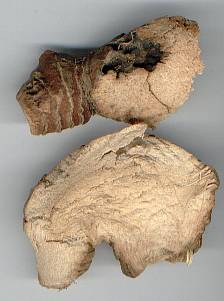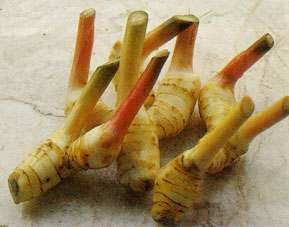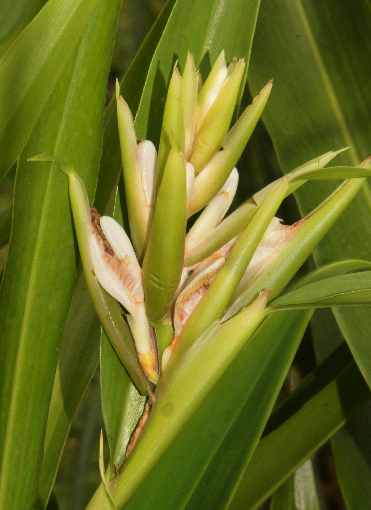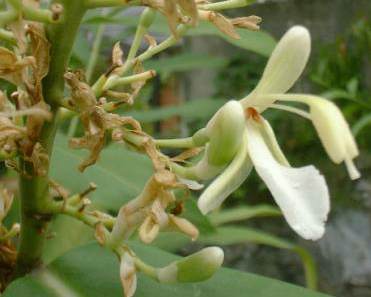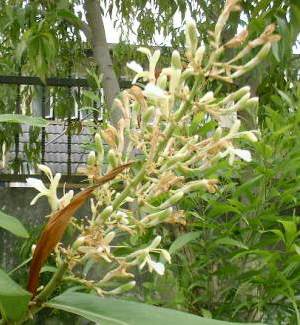
|
| Flower cluster of galanga |
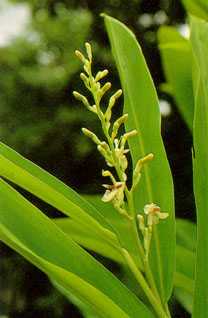
|
|
Galanga flower
kanchanapisek.or.th |
Galangale may be used fresh or dried, which makes a great difference in flavour. Fresh galanga has a pure and refreshing odour and a mildly spicy flavour; it is the galanga of choice for all Thai foods, where thin slices of galanga are often added to soups, e. g., to the well-known tom khaa [ต้มข่า] which basically is a variant of tom yam [ต้มยำ] (kaffir lime) with galanga and coconut milk. Moreover, galanga is often used, finely cut or chopped, for stir-fries; and last but not least, ground fresh galanga rhizome is an essential ingredient in most curry pastes (see coconut for a discussion on these typical Thai flavouring). Like ginger, its aroma merges well with garlic.
Dried and powdered galanga is less fresh but more spicy, something in between of ginger and cinnamon. Dried galanga is also sold if form of slices that must be reconstituted in warm water and come closer to fresh galanga in their flavour.
In most South East Asian countries dried galanga is
employed only whenever fresh galanga is not available.
Indonesians, for example, frequently
use slices or powder of the fresh or dried rhizome, e. g., for nasi
goreng (fried rice with vegetables and meat) or for the characteristically
sweet Jawanese curries (see tamarind).

|
| Galanga (plant) |
Another well-known Indonesian dishes which makes use of dried galanga is rendang, a spicy beef (or buffalo) stew. Cubed beef is cooked in thick coconut milk together with dried chiles, garlic and dried turmeric, ginger, Indonesian bay-leaves and galangale; some recipes additionally prescribe Indonesian cinnamon, black pepper or even fennel. Rendang is famous both for the soft texture of the otherwise tough buffalo meat and for its hot and aromatic flavour; even for ordinary beef, I found a cooking time of three hours appropriate, unless the procedure is sped up by using a pressure cooker.
Rendang is a great example of the food style called
nasi Padang Padang-food
in Indonesia. It
originates from Western Sumatra province (Sumatra barat)
and is named after the capital Padang. The region is inhabited by the
Islâmic minangkabau people who are known all
over Indonesia for their strong breeds of buffalo. By Indonesian standards,
Padang food is quite spicy; due to much domestic migration,
nasi Padang
has become available and popular all over the country, and can
thus also be enjoyed in Jawa or Bali.
Galangale is sometimes confused with other spices of the ginger family; see lesser galangale for details. Its taste and appearance
are, however, characteristic; it cannot be substituted by any other spice.

